
The Bottom Line
Introduction, Drive Specifications, Pricing and Availability
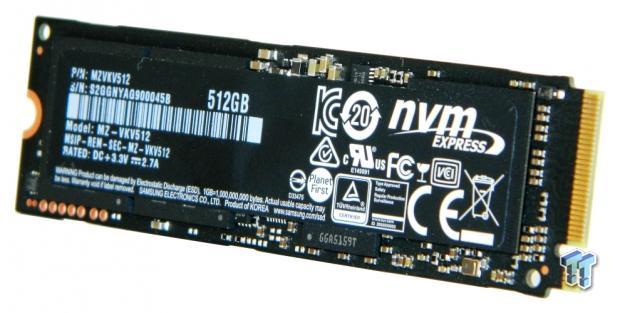
Since the introduction of the 840 Pro, Samsung has produced the best-selling, best-performing consumer SSDs on the market. Today, Samsung is again raising the bar with the introduction of the 950 Pro. The 950 Pro isn't the first retail NVMe consumer SSD on the market, it's second in that respect, but it is the world's first consumer based NVMe SSD powered by 3D Flash technology.
Intel was first to the game with their 750 Series NVMe SSDs, and the 950 Pro is the second retail NVMe SSD. Intel and Samsung take completely different approaches to their consumer-based SSDs. Intel is enterprise first, consumer variant second. Samsung is consumer first, and then enterprise variant. Both of these approaches have their merits. For Intel, it's proven reliability. For Samsung, it's SSDs that are specifically designed to perform in a consumer environment.
Intel's 750 Series SSDs are essentially enterprise SSDs with consumer flash. Enterprise SSD's are designed to deliver peak performance at deep queue depths, which is not ideal for consumer applications. This why the 750 Series was actually outperformed in consumer applications by Samsung's 256GB SM951 M.2 NVMe SSD in our testing. When we tested the SM951 NVMe OEM SSD, which was the precursor to the 950 Pro, we were blown away by its performance in consumer applications. However, we occasionally ran into issues when running the OEM drive. At times, the SM951 would run hot, and we had issues where the drive would inexplicably run at far below its expected performance even when it was not hot. We chose not to highlight these problems in our SM951 NVMe review for one reason; the SM951 NVMe is an OEM SSD, designed specifically to perform as advertised only with specific OEM hardware.
In our SM951 NVMe review, we speculated that Samsung would be introducing a full blown retail M.2 NVMe SSD soon, and that's exactly what we have in the 950 Pro. The 950 Pro utilizes the same proprietary UBX 3-core 8-channel controller as the SM951, but there is a big difference in the NAND Flash. The 950 Pro employ's Samsung's second generation 3D V-NAND Flash; the same utilized on the 850 Pro. We don't know if the V-NAND Flash is running cooler, or the controller firmware has been tweaked or it's a combination of both that has eliminated the heat issues, but we can tell you up front that we experienced no heat related issues whatsoever with the 950 Pro.
As mentioned heat wasn't the only issue we had when testing the SM951, we also experienced inexplicable performance drops. We felt like the issue was likely due to the lack of a proprietary NVMe driver. I approached Samsung with the question of a proprietary driver, and at the time they stated they had no plans for a proprietary NVMe driver. I guess Samsung changed their mind, because a month ago at the 2015 Samsung Global SSD Summit, Samsung announced a proprietary NVMe driver that would be used in conjunction with the 950 Pro. Samsung stated this driver was aimed at providing superior performance and reliability. We will again tell you up front that this driver solved the performance issues we experienced with the SM951. There is another aspect of a proprietary driver that is often overlooked, and that's a bootable NVMe drive for Windows 7 users. The driver we received from Samsung was an installer only setup. Windows 7 users will need an "F6" version, like Intel provides for the 750 series, for a bootable NVMe installation.
Samsung is advertising the 950 Pro as an SSD that will deliver a next-generation SSD experience today. After testing the 950 Pro, we could not agree more. The 950 Pro is the best performing consumer SSD we have ever tested. More than that, we feel that the 950 Pro is rock solid and will deliver reliability on par with Intel's 750 Series as evidenced by the drives TBW rating. The 950 Pro is the only SSD ever to receive a TweakTown rating of 100 percent. The 950 Pro is THAT good!
With new hardware converging and TweakTown updating our consumer SSD test bed, we wanted to take this review from the approach of an enthusiast building a new system. We normally image our OS onto the test subject, and then fill it with data to 75% of the drive's capacity. For this review, we started with a blank slate. We chose an ASRock Z170 OC Formula motherboard, Intel 6700K processor, 16GB Corsair Vengeance LPX DDR4 3200 DRAM and Windows 10 Pro retail OS to utilize for this review. Our build and OS install on the 950 Pro went smooth as silk; we encountered no issues.
Let's get into the review so we can show you why we believe the Samsung 950 Pro is the best performing consumer SSD to date.
Specifications: Samsung 950 Pro M.2 PCIe Gen 3x4 NVMe SSD
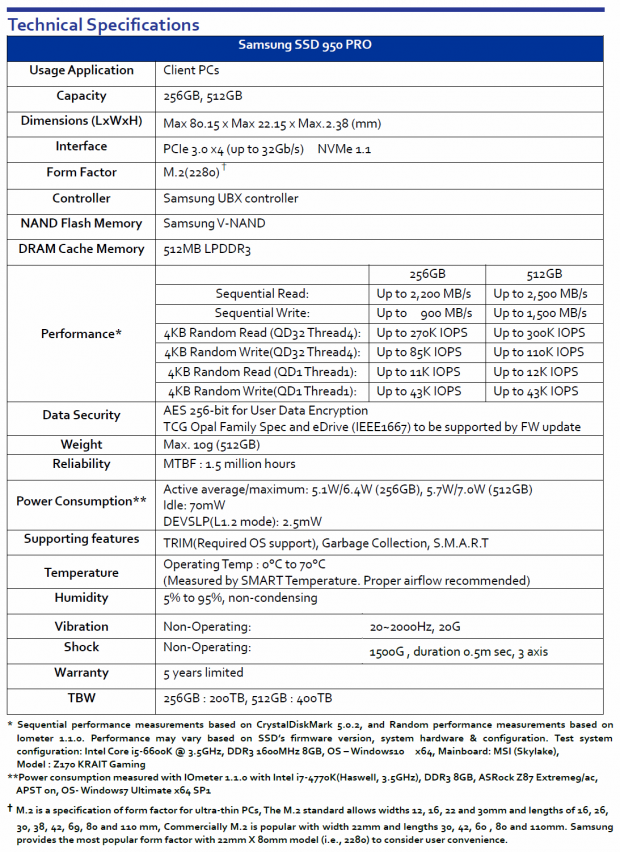
Samsung's 950 Pro NVMe SSD is available in two capacities: 256GB and 512GB. Sequential read performance varies by capacity up to 2500 MB/s maximum. Sequential write performance varies by capacity up to 1500 MB/s maximum. The drive delivers up to 300,000 Random Read IOPS and 110,000 Random Write IOPS. 4K QD1 random read performance is listed at up to 12K IOPS. 4K QD1 random write performance is listed at up to 43K IOPS. LBA addressing is handled by a single Samsung 512MB LPDDR3 DRAM package at both capacity points. TBW (Total Bytes Written) checks in at 200TB for the 256GB capacity and 400TB for the 512GB model.
The 256GB model is slated to retail for $199.99, and the 512GB for $349.99. Samsung backs the 950 Pro with a five-year limited warranty.
Drive Details
Samsung 950 Pro M.2 PCIe Gen 3x4 NVMe SSD
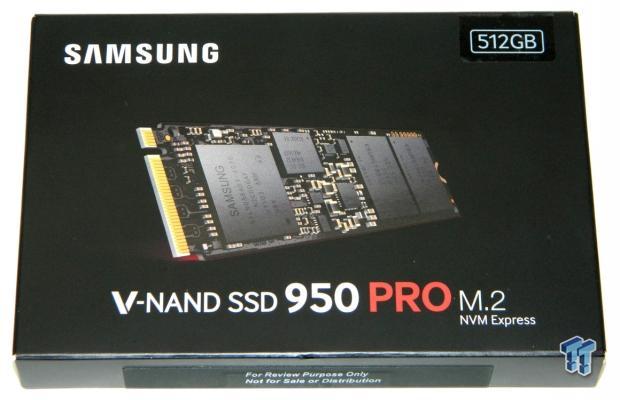
The 950 Pro retails in a small black box with a picture of the drive on the front. The drives capacity is given on the top right corner of the box.
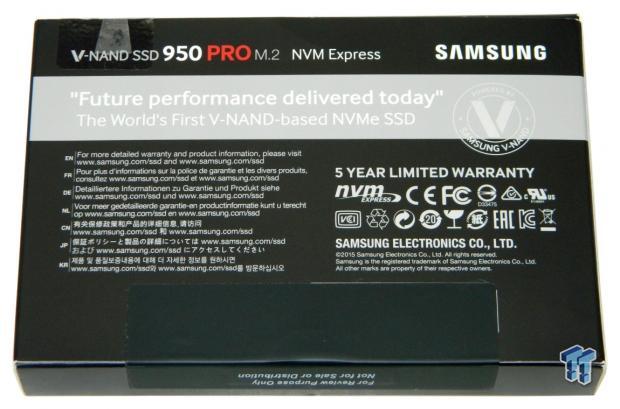
The rear of the packaging informs us that the 950 Pro will deliver future performance today and that the 950 Pro is the world's first V-NAND-based NVMe SSD.
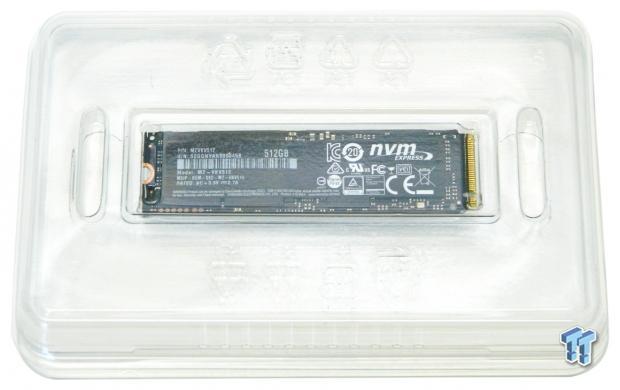
Inside the box, the drive is cradled in a clear plastic enclosure for protection.

The front of the tiny black PCB's IC's are covered with a manufacturer's label. The label lists the drives capacity, serial number, model number and other relevant information.

The back half of the black PCB is devoid of components.

The drives UBX tri-core 8-channel controller, 512MB LPDDR3 DRAM cache package and both of the drives 256GB flash packages are located on this side of the 22x80mm PCB.
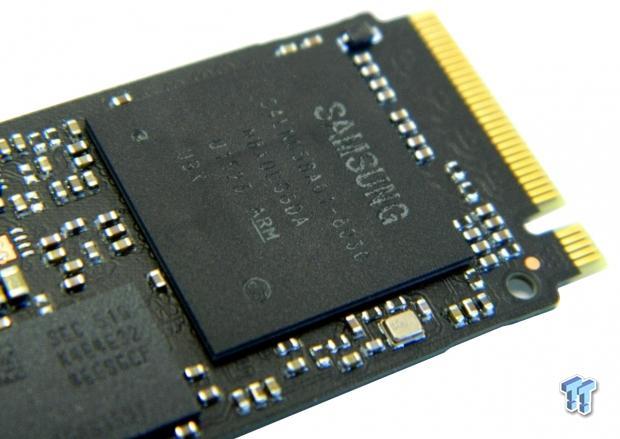
A close-in view of the ARM-based 8-channel Samsung UBX controller that powers the 950 Pro.
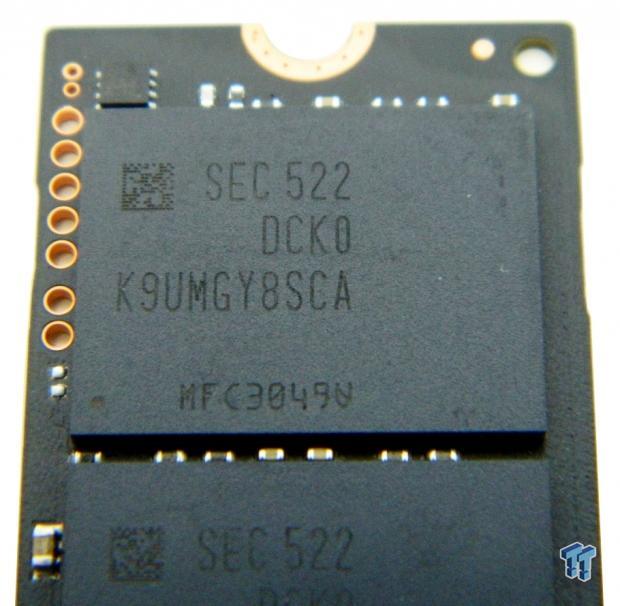
A close-in view of one of the drive's two 256GB V-NAND flash packages.
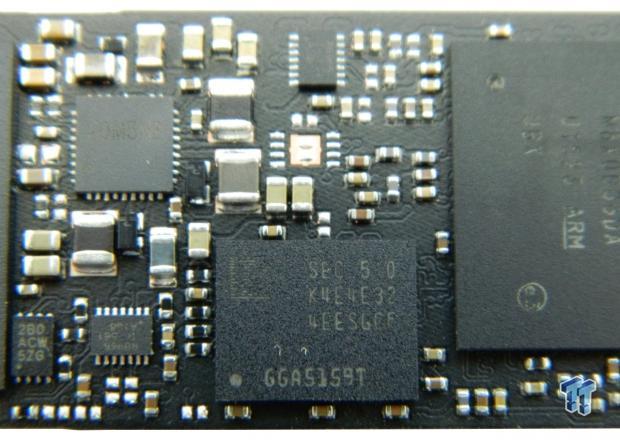
Finally, a close-in view of the drives 512MB LPDDR3 Samsung DRAM package.
Test System Setup and Properties
Jon's Consumer SSD Review Test System Specifications
- Motherboard: ASRock OC Formula Z170 - Buy from Amazon / Read our review
- CPU: Intel Core i7 6700K @ 4.7GHz - Buy from Amazon / Read our review
- Cooler: Swiftech H2O-320 Edge - Buy from Amazon / Read our review
- Memory: Corsair Vengeance LPX DDR4 16GB 3200MHz - Buy from Amazon
- Video Card: Onboard Video
- Case: IN WIN X-Frame - Buy from Amazon / Read our review
- Power Supply: Seasonic Platinum 1000 Watt Modular - Buy from Amazon / Read our review
- OS: Microsoft Windows 10 Professional 64-bit - Buy from Amazon
- Drivers: Intel RAID option ROM version 14.6.0.1029 and Intel RST driver version 13.6.0.1002
We would like to thank ASRock, Crucial, Intel, Corsair, RamCity, IN WIN, and Seasonic for making our test system possible.
Drive Properties
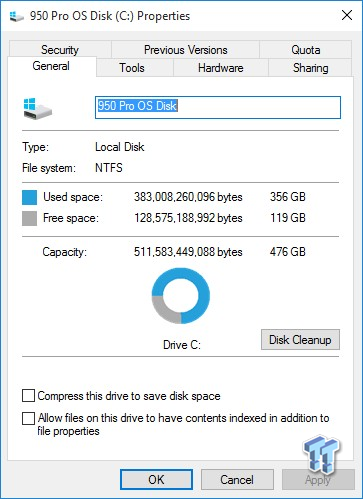
The majority of our testing is performed with our test drive as our boot volume. Our boot volume is 75% full for all OS Disk "C" drive testing to replicate a typical consumer OS volume implementation. We feel that most of you will be utilizing your SSDs for your boot volume and that presenting you with results from an OS volume is more relevant than presenting you with empty secondary volume results.
System settings: Cstates and Speed stepping are both disabled in our systems BIOS. Windows High Performance power plan is enabled. Windows write caching is enabled, and Windows buffer flushing is disabled. We are utilizing Windows 10 Pro 64-bit for all of our testing except for our MOP (Maxed-Out Performance) benchmarks where we switch our OS to Windows Server 2008 R2 64 Bit.
Synthetic Benchmarks - ATTO & Anvil Storage Utilities
ATTO
Version and / or Patch Used: 3.05
ATTO is a timeless benchmark used to provide manufacturers with data used for marketing storage products.
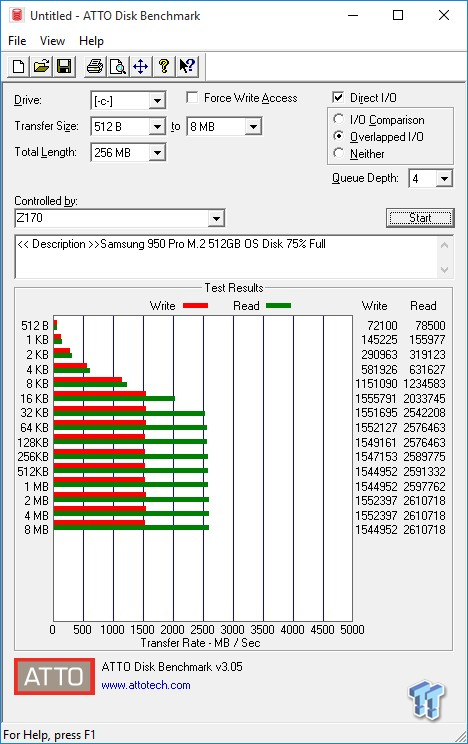
Sequential read/write transfers max out at 2611/1556 MB/s. Keep in mind this is our OS volume 75% full.
Sequential Write
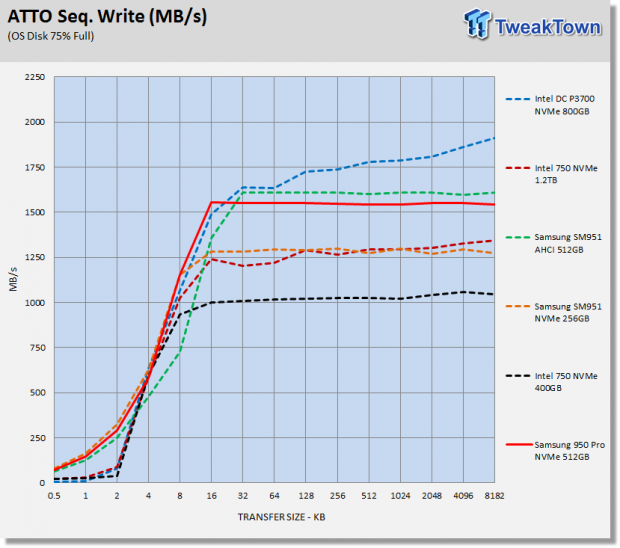
Both Samsung NVMe drive's (950 Pro and SM951 NVMe) ramp up faster than the rest of the test pool. The SM951 AHCI tops out with a slightly higher sequential write performance than the Samsung NVMe drives. The P3700 enterprise SSD we included in our charts for a point of comparison delivers the highest sequential write speed.
Sequential Read
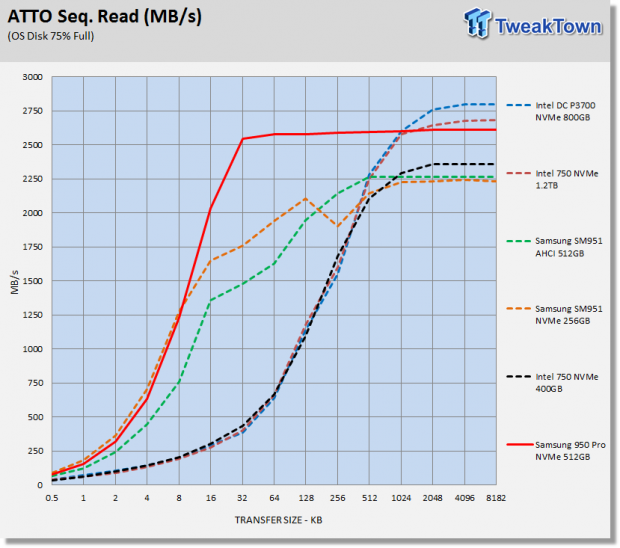
These test results point directly to why we believe the 950 Pro will provide superior performance to the Intel 750 in a typical enthusiast environment. The 950 Pro outperforms the competition by as much as 8x with small sequential read transfers of up to 1024KB.
Anvil Storage Utilities
Version and / or Patch Used: 1.1.0
Anvil's Storage Utilities is a storage benchmark designed to measure the storage performance of SSD's. The Standard Storage Benchmark performs a series of tests; you can run a full test or just the read or write test, or you can run a single test, i.e. 4k QD16.
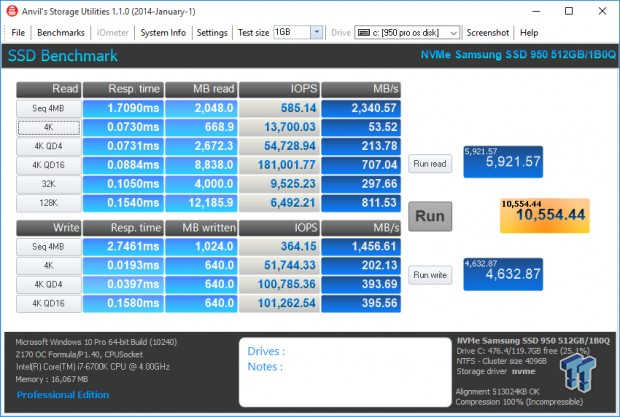
Scoring
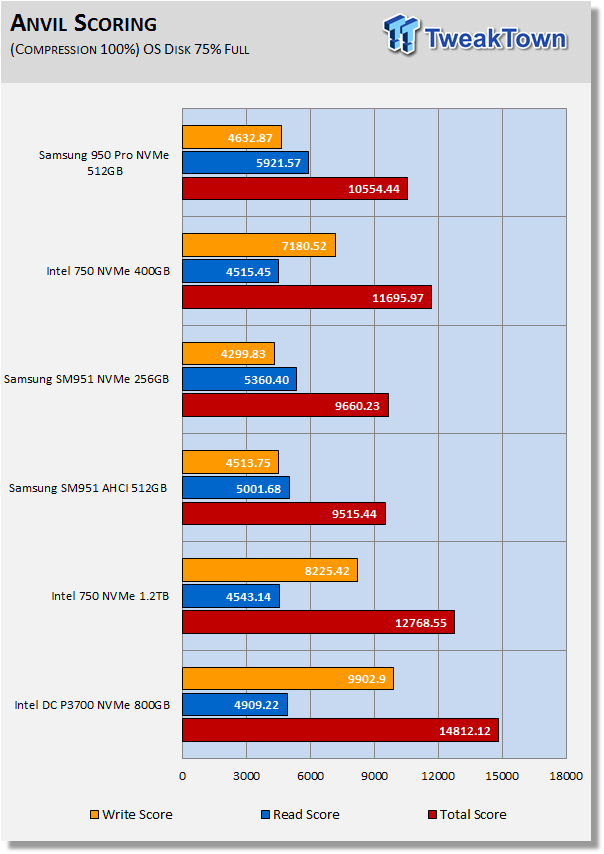
The 750 Series SSDs put up better overall scores than the 950 Pro. However when we dig a bit deeper, we can see the 950 Pro is delivering far better random read performance at consumer queue depths than the 750 Series. The 950 Pro's read score is the highest we've ever seen from a single SSD in this test. The 750's dominate in the random write department.
So, what matters more? With SATA SSDs, drives with the best 4K QD1 (incompressible) random write performance tend to be the best overall performers in a consumer environment. With NVMe SSD's we are finding that the opposite is true, 4K QD1 (incompressible) random read performance seems to be the best performance indicator available from synthetic testing.
(Anvil) Read IOPS through Queue Depth Scale

The Samsung NVMe SSDs lead the field from QD1-QD32 (consumer queue depths). This test illustrates perfectly how much better random read performance is on the NVMe interface than AHCI. Compare the maximum IOPS of the 950 Pro to that of the SM951 AHCI. The two drives are nearly identical with the exception of the interface. The 950 Pro can deliver nearly double the read IOPS of the SM951 AHCI drive.
(Anvil) Write IOPS through Queue Scale
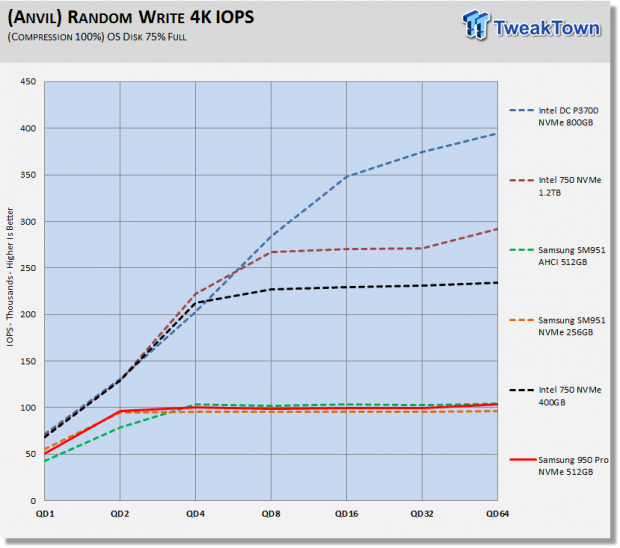
The Intel drives deliver much better random write performance than the Samsung's. We will see how this shakes out with our consumer workload tests.
Synthetic Benchmarks - CrystalDiskMark & AS SSD
CrystalDiskMark
Version and / or Patch Used: 3.0 Technical Preview
CrystalDiskMark is disk benchmark software that allows us to benchmark 4k and 4k queue depths with accuracy. Note: Crystal Disk Mark 3.0 Technical Preview was used for these tests since it offers the ability to measure native command queuing at QD4.
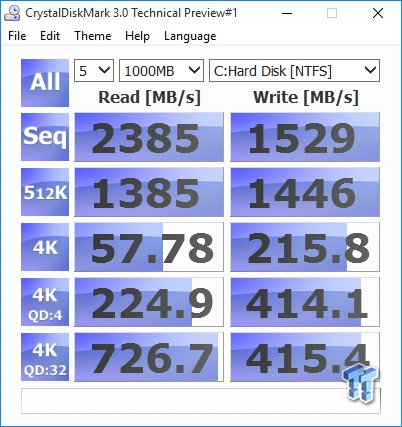
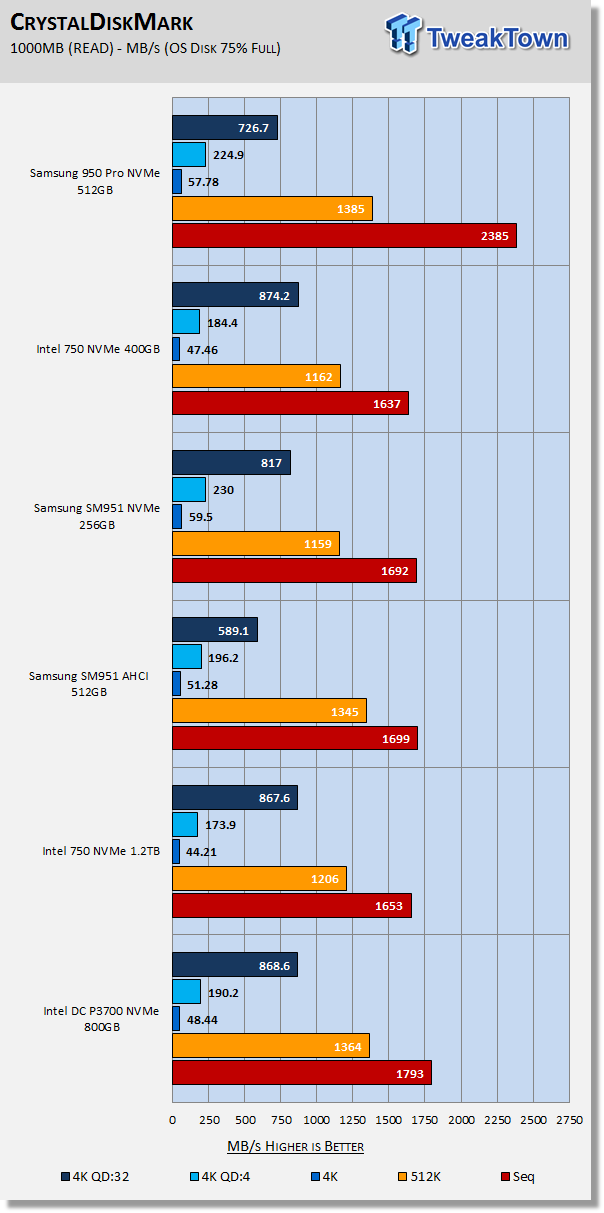
Looking at sequential read performance, we are hitting close to 2400 MB/s. Samsung specs the 950 Pro 512GB at 2500 MB/s using CDM. There are two reasons we are not hitting spec, first this is our OS volume, and it's 75% full. Second, we are using a different version of CDM, which measures sequential performance at QD1.
The 950 Pro easily outperforms the Intel NVMe drives sequentially and with random 4K read data at queues up to QD32.
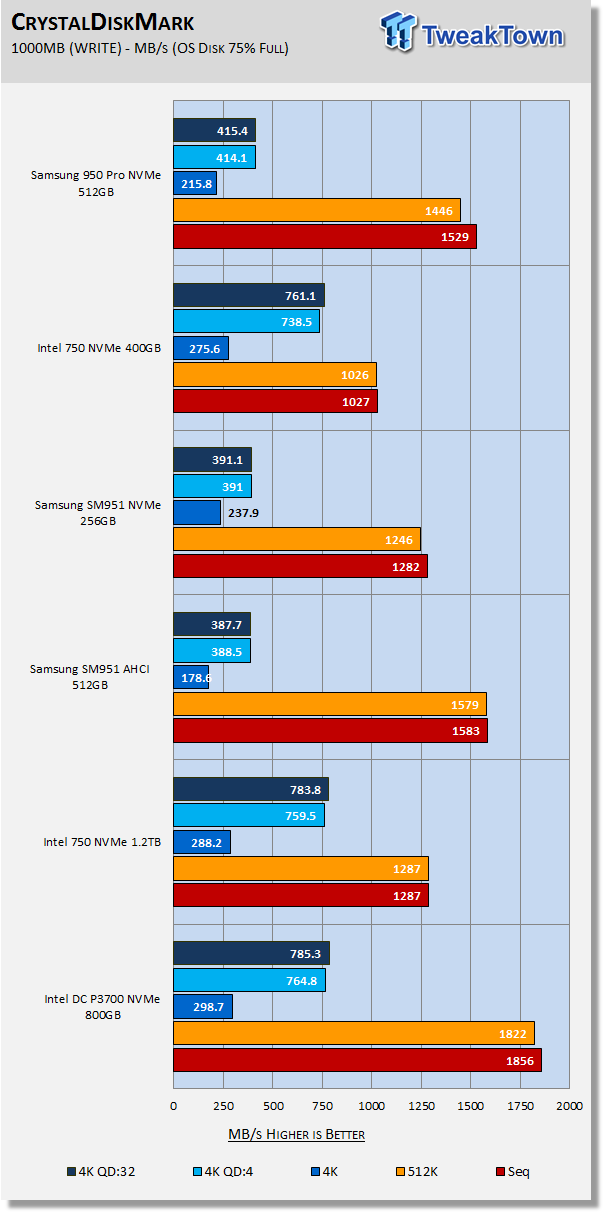
The 950 Pro delivers better sequential write performance than the 750 Series SSDs. However, the 750 Series SSDs easily outperform the 950 Pro when writing random 4K data.
AS SSD
Version and / or Patch Used: 1.7.4739.38088
AS SSD determines the performance of Solid-State Drives (SSD). The tool contains four synthetic as well as three practice tests. The synthetic tests are to determine the sequential and random read and write performance of the SSD.
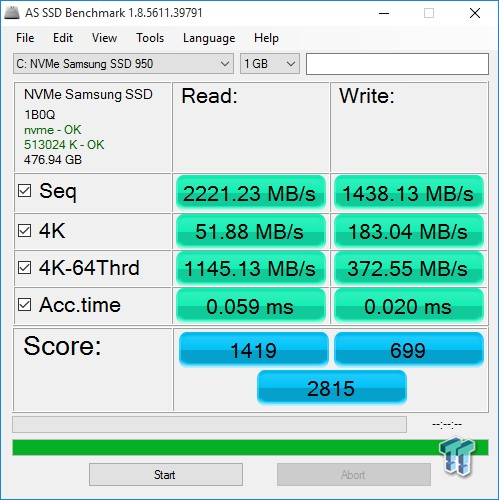
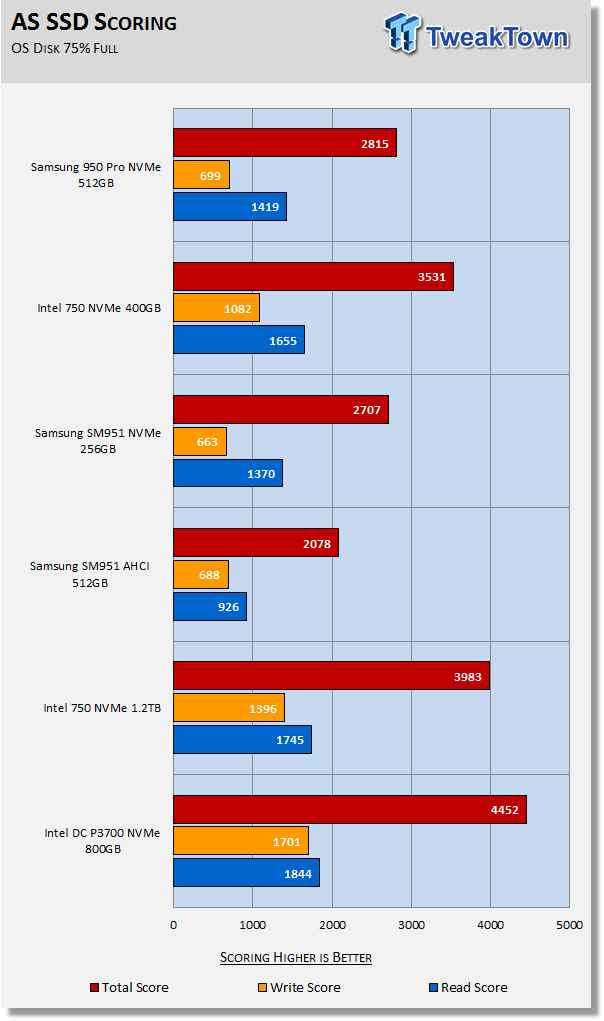
So much of AS SSD's scoring comes from 4K-64 thread performance (which is nearly irrelevant in a consumer setting) that overall scoring may not reflect what can be expected in terms of real-world performance. We still use AS SSD because it's a very popular test that many enthusiasts use and scoring aside, it does provide important data.
With our synthetic testing out of the way, let's take a look at our moderate workload testing.
Benchmarks (Trace Based OS Volume) - PCMark Vantage, PCMark 7 & PCMark 8
Moderate Workload Model
We categorize these tests as indicative of a moderate workload environment.
PCMark Vantage - Hard Disk Tests
Version and / or Patch Used: 1.2.0.0
The reason we like PCMark Vantage is because the recorded traces are played back without system stops. What we see is the raw performance of the drive. This allows us to see a marked difference between scoring that other trace-based benchmarks do not exhibit. An example of a marked difference in scoring on the same drive would be empty vs. filled vs. steady state.
We run Vantage three ways. The first run is with the OS drive 75% full to simulate a lightly used OS volume filled with data to an amount we feel is common for most users. The second run is with the OS volume written into a "Steady State" utilizing SNIA's guidelines. Steady state testing simulates a drives performance similar to that of a drive that been subjected to consumer workloads for extensive amounts of time. The third run is a Vantage HDD test with the test drive attached as an empty secondary storage device.
OS Volume 75% Full - Lightly Used
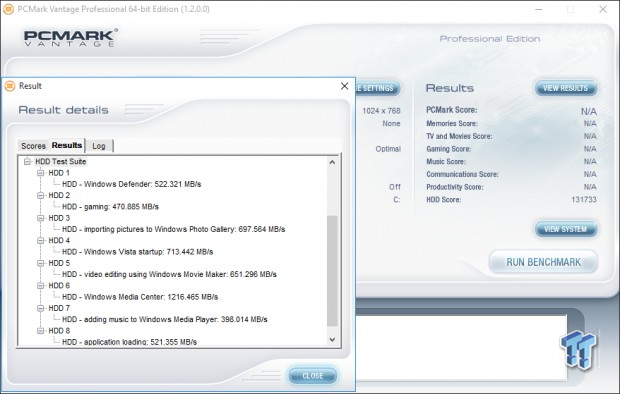
OS Volume 75% Full - Steady State
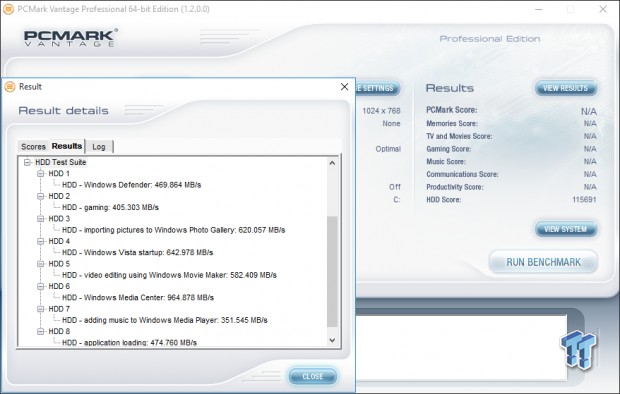
Secondary Volume Empty - FOB
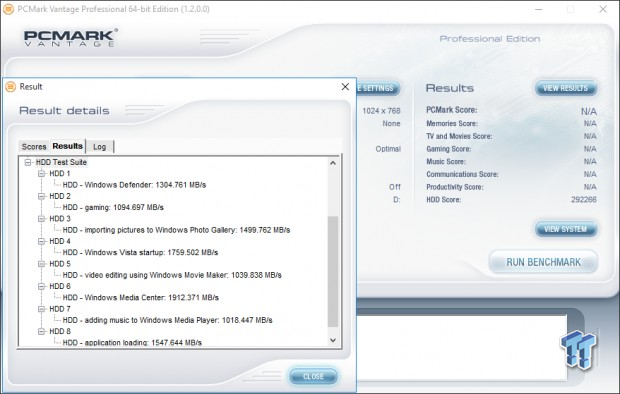
There's a big difference between an empty drive, one that's 75% full/used, and one that's in a steady state.
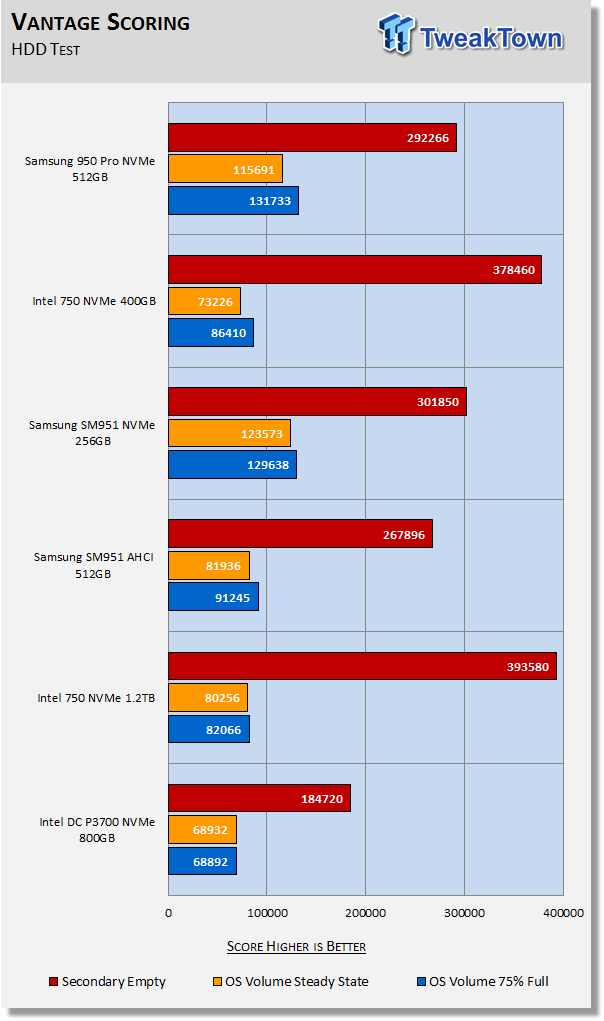
The important scores to pay attention to are "OS Volume Steady State" and "OS Volume 75% full." These two categories are most important because they are indicative of typical of consumer user states. When a drive is in a steady state, it means garbage collection is running at the same time it's reading/writing. This is exactly why we focus on steady state performance.
At 75% full and lightly used, the 950 Pro delivers the best score of our test pool. Its 52% better than the 400GB 750 Series. In a steady state, the 950 Pro outperforms the 1.2TB 750 series by 44%. This is solid evidence that the 950 Pro will deliver superior performance to the 750 Series in a typical consumer OS environment.
PCMark 7 - System Storage
Version and / or Patch Used: 1.4.0
We will look to Raw System Storage scoring for evaluation because it's done without system stops and, therefore, allows us to see significant scoring differences between drives.
OS Volume 75% Full - Lightly Used
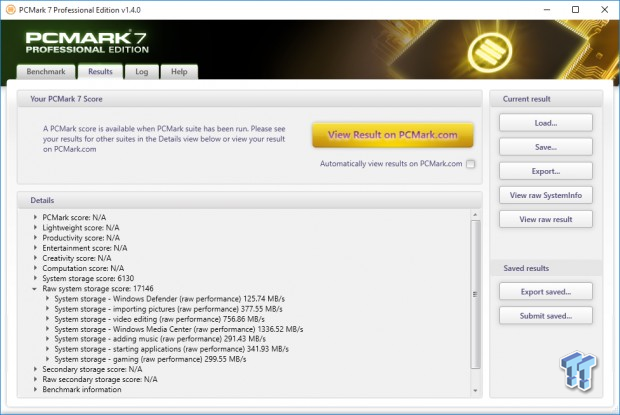
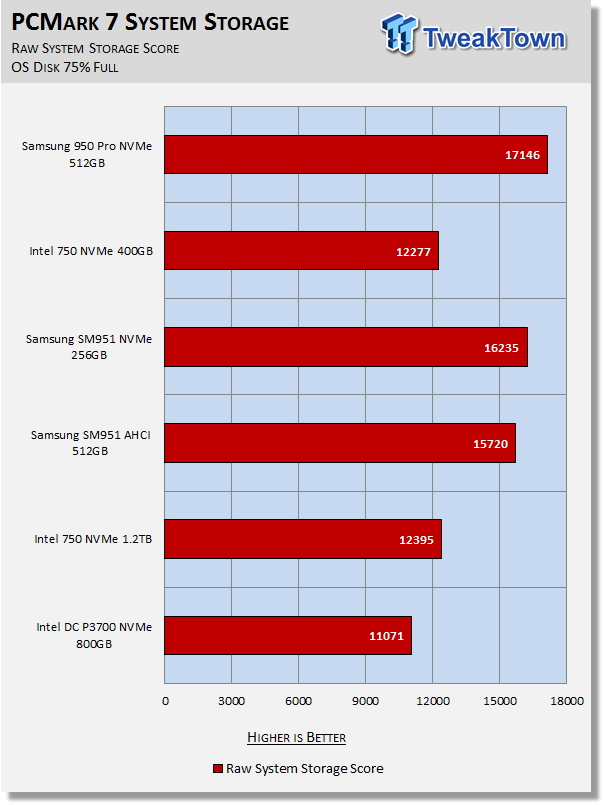
17,000 is a new lab record for a single SSD. In this real-world test, the 950 Pro outperforms the 1.2TB Intel 750 Series by 38%.
PCMark 8 - Storage Bandwidth
Version and / or Patch Used: 2.5.419
We use PCMark 8 Storage benchmark to test the performance of SSDs, HDDs, and hybrid drives with traces recorded from Adobe Creative Suite, Microsoft Office, and a selection of popular games. You can test the system drive or any other recognized storage device, including local external drives. Unlike synthetic storage tests, the PCMark 8 Storage benchmark highlights real-world performance differences between storage devices.
OS Volume 75% Full - Lightly Used
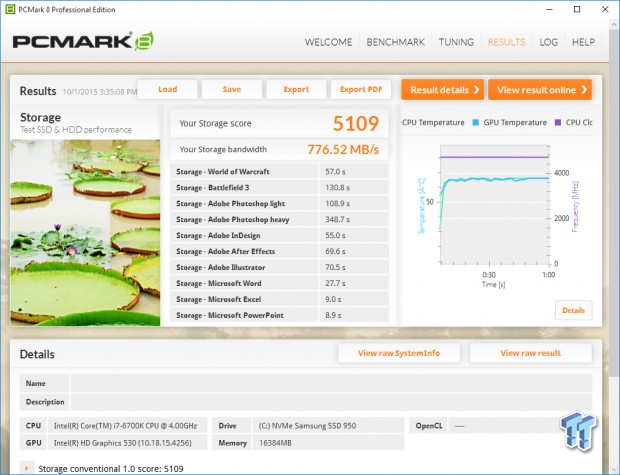
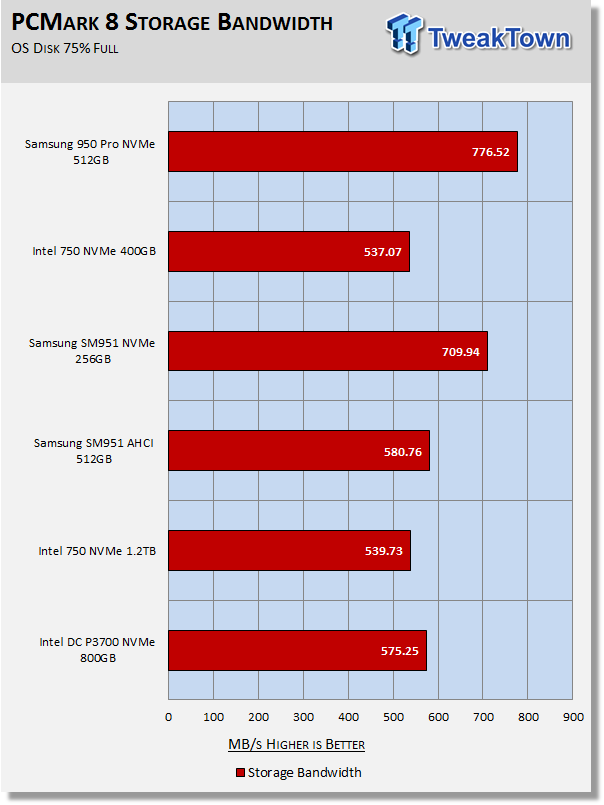
PCMark 8 is the most intensive moderate workload simulation we run. With respect to moderate workloads, this test is what we consider the best indicator of a drive's performance. We are blown away by this performance. This test perfectly illustrates that the 950 Pro is ideally tuned for a consumer workload environment. The 950 Pro can deliver 236.79 MB/s or 44% more storage bandwidth than the 1.2TB 750 Series SSD.
Again, comparing the SM951 AHCI to the 950 Pro, it's apparent just how much more performance the NVMe interface is capable of delivering.
Benchmarks (Secondary Volume) - Max IOPS, Disk Response & Transfer Rates
Iometer - Maximum IOPS
Version and / or Patch Used: Iometer 2014
We use Iometer to measure high queue depth performance. (No Partition)
Max IOPS Read 8-Workers QD 256
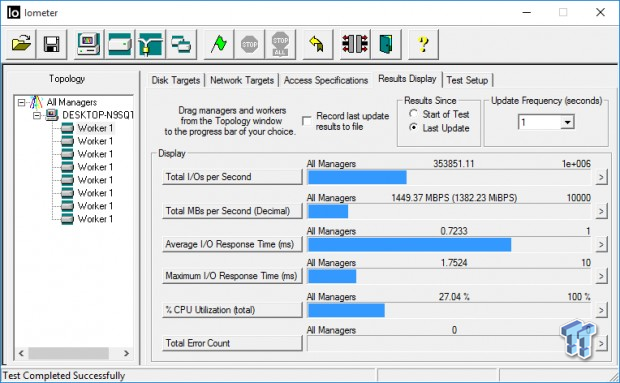
Max IOPS Write 8-Workers QD 256
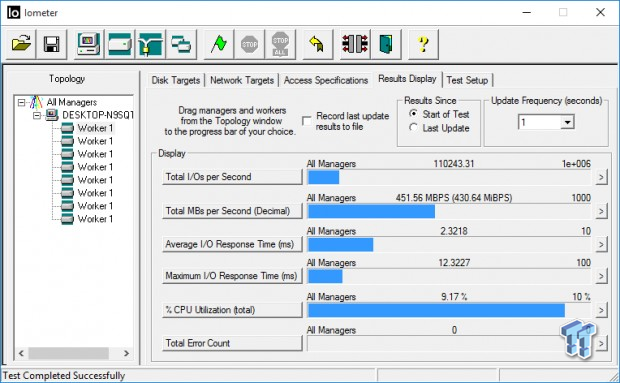
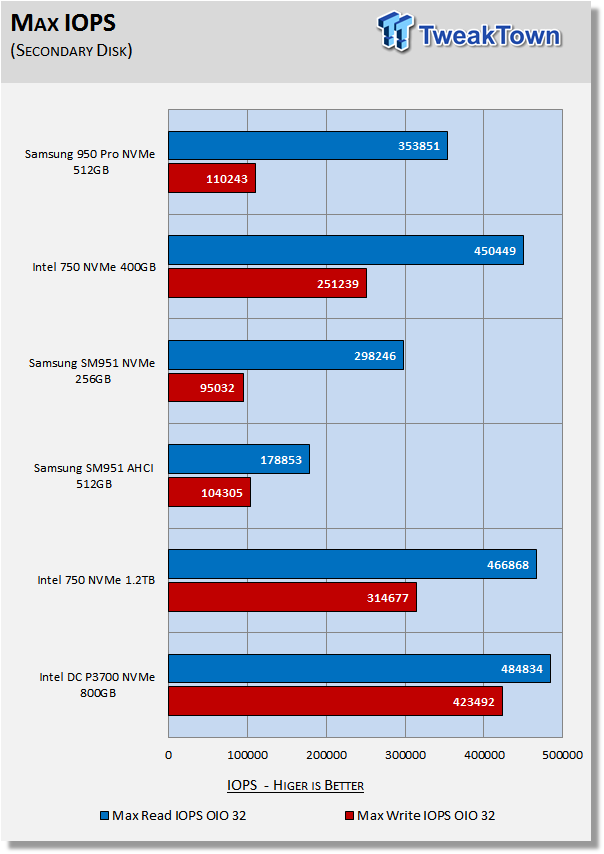
Our test system can churn out 53,000 more read IOPS than Samsung's specification of 300K IOPS. Look at it like this; you will spend $1 per 10K read IOPS when you purchase a 512GB 950 Pro. Looking at write IOPS, our test system is just able to hit the specified 110K write IOPS. The 750 Series SSDs with their enterprise DNA can easily exceed the 950 Pro's maximum IOPS.
Iometer - Disk Response
Version and / or Patch Used: Iometer 2014
We use Iometer to measure disk response times. Disk response times are measured at an industry accepted standard of 4K QD1 for both write and read. Each test runs twice for 30 seconds consecutively, with a 5-second ramp-up before each test. We partition the drive/array as a secondary device for this testing.
Avg. Write Response
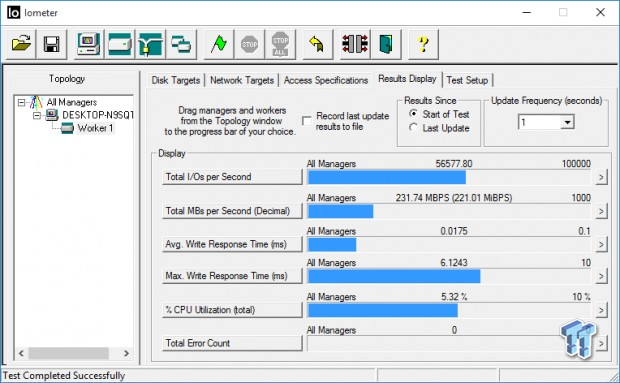
Avg. Read Response
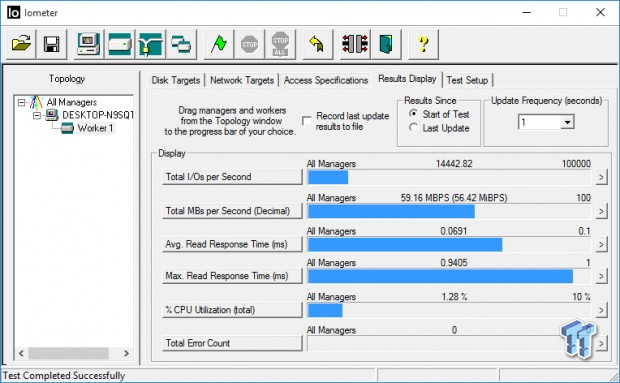
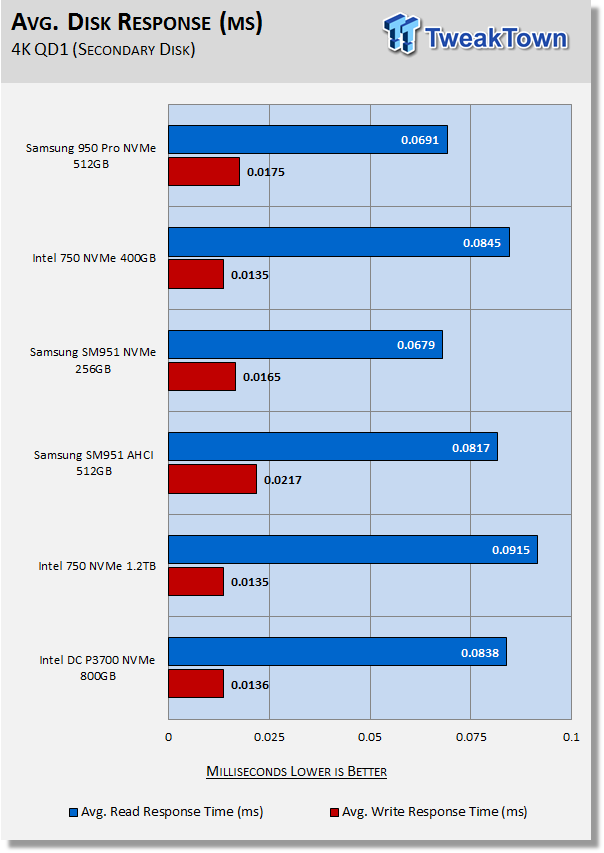
The 750 series SSDs have superior write response times, and the 950 Pro superior read response times. This test is performed at 4K QD1 utilizing Iometer 1.1.0. This is the same test Samsung uses to quote 4K QD1 read/write performance. Samsung specs up to 12K/43K IOPS, we hit 14.4K/56.5K IOPS with the very same test, indicating that Samsung's specifications are very conservative.
DiskBench - Directory Copy
Version and / or Patch Used: 2.6.2.0
We use DiskBench to time a 28.6GB block (9,882 files in 1,247 folders) composed primarily of incompressible sequential and random data as it's transferred from our DC P3700 PCIe NVME SSD to our test drive. We then read from a 6GB zip file that's part of our 28.6GB data block to determine the test drives read transfer rate. Our system is restarted prior to the read test to clear any cached data, ensuring an accurate test result.
Write Transfer Rate
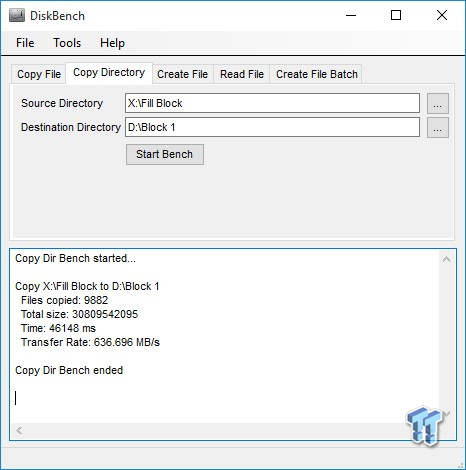
Read Transfer Rate
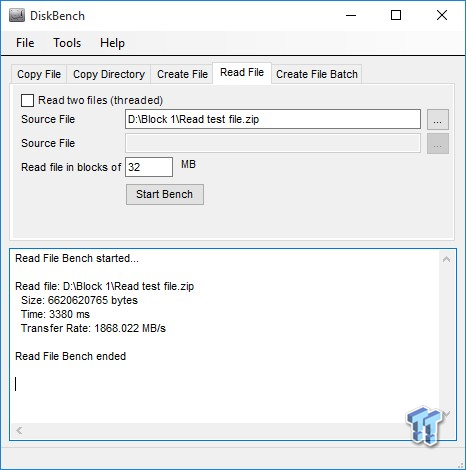
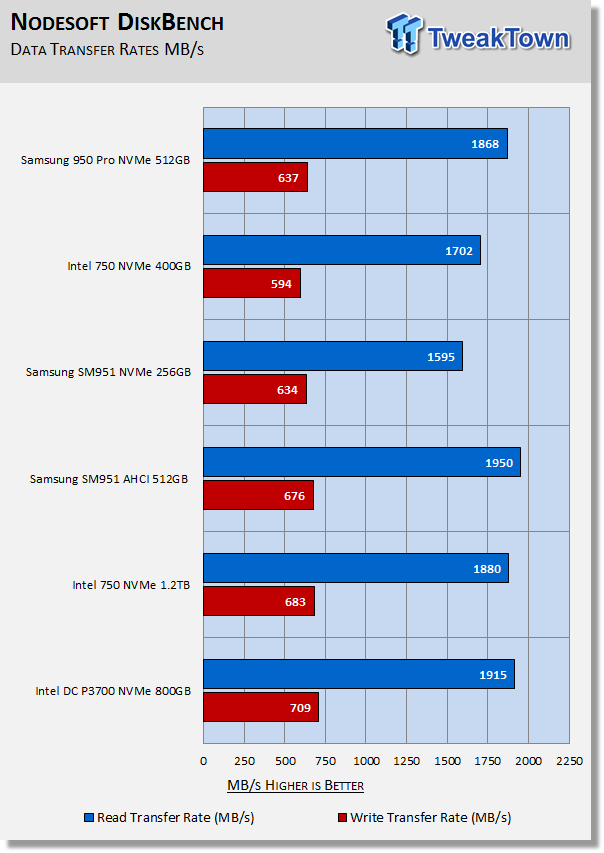
The Intel 1.2TB 750 outperforms the 950 Pro in this testing delivering ever so slightly superior transfer rates. Interestingly enough, the SM951 AHCI also delivers superior transfer rates in comparison to the 950 Pro. This outcome is almost certainly because we did not secure erase the 950 Pro prior to this test. Both the 1.2TB 750 and the SM951 AHCI were secure erased prior to this test.
Benchmarks (Secondary Volume) - PCMark 8 Extended
Futuremark PCMark 8 Extended
Heavy Workload Model
PCMark 8's consistency test simulates an extended duration heavy workload environment. PCMark 8 has built-in, command line executed storage testing. The PCMark 8 Consistency test measures the performance consistency and the degradation tendency of a storage system.
The Storage test workloads are repeated. Between each repetition, the storage system is bombarded with a usage that causes degraded drive performance. In the first part of the test, the cycle continues until a steady degraded level of performance has been reached. (Steady State)
In the second part, the recovery of the system is tested by allowing the system to idle and measuring the performance after 5-minute long intervals. (Internal drive maintenance: Garbage Collection (GC)) The test reports the performance level at the start, the degraded steady-state, and the recovered state, as well as the number of iterations required to reach the degraded state and the recovered state.
We feel Futuremark's Consistency Test is the best test ever devised to show the true performance of solid-state storage in an extended duration heavy workload environment. This test takes on average 13 to 17 hours to complete and writes somewhere between 450GB and 14,000GB of test data depending on the drive. If you want to know what an SSD's steady state performance is going to look like during a heavy workload, this test will show you.
Here's a breakdown of Futuremark's Consistency Test:
Precondition phase:
1. Write to the drive sequentially through up to the reported capacity with random data.
2. Write the drive through a second time (to take care of overprovisioning).
Degradation phase:
1. Run writes of random size between 8*512 and 2048*512 bytes on random offsets for 10 minutes.
2. Run performance test (one pass only).
3. Repeat 1 and 2 for 8 times, and on each pass increase the duration of random writes by 5 minutes.
Steady state phase:
1. Run writes of random size between 8*512 and 2048*512 bytes on random offsets for 50 minutes.
2. Run performance test (one pass only).
3. Repeat 1 and 2 for 5 times.
Recovery phase:
1. Idle for 5 minutes.
2. Run performance test (one pass only).
3. Repeat 1 and 2 for 5 times.
Storage Bandwidth
PCMark 8's Consistency test provides a ton of data output that we use to judge a drive's performance.
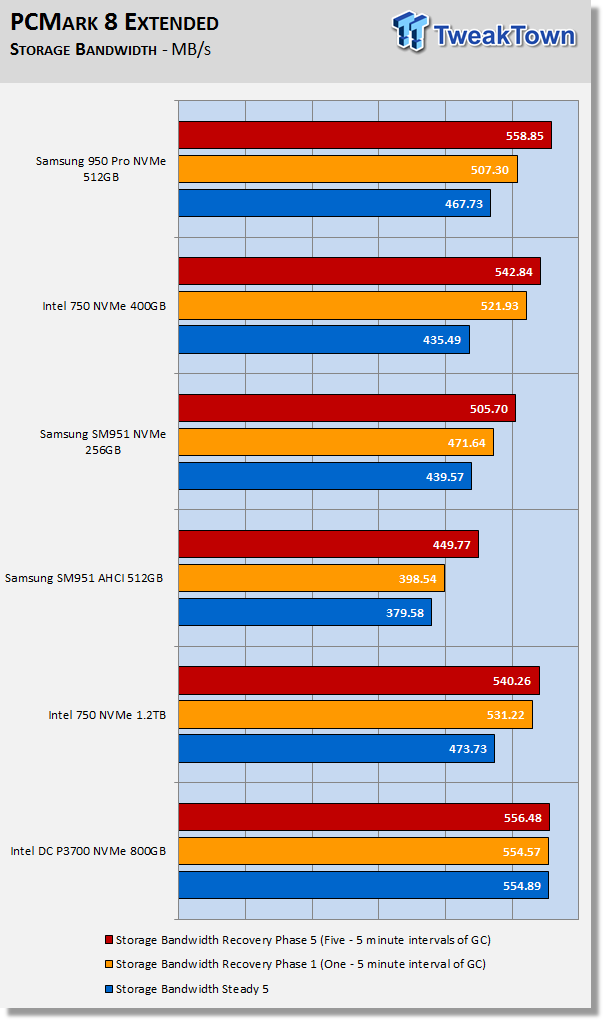
We consider steady state bandwidth (the blue bar) our test that carries the most weight in ranking a drive/arrays heavy workload performance. Performance after Garbage Collection (GC) (the orange and red bars) is what we consider the second most important consideration when ranking a drives performance. Trace-based steady state testing is where true high performing SSDs are separated from the rest of the pack.
This test is almost enterprise class in nature. This is why the P3700 in a steady state handily outperforms the rest of the test pool composed of consumer class SSD's. The 1.2TB 750 and the 950 Pro are performing essentially the same in a steady state. After five minutes of recovery, the 1.2TB 750 has a small advantage. After 5 five minute intervals of recovery, the 950 Pro is outperforming every drive on our chart including the P3700. Again, we have an excellent illustration of how much better the NVMe drives perform in comparison to the SM951 AHCI.
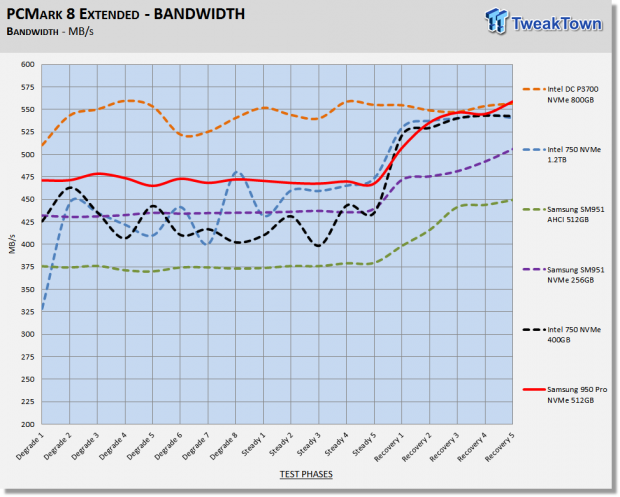
We chart our test subject's storage bandwidth as reported at each of the test's 18 trace iterations. This gives us a good visual perspective of how our test subjects perform as testing progresses. What jumps out at us is just how little performance variability in the degrade and steady-state phases of the test the Samsung drives display. The Intel drives all have a wave pattern displaying significant variability. This chart makes it very clear that overall the 950 Pro is easily outperforming the 1.2TB 750 series in terms of storage bandwidth for 90% of the test.
Total Access Time (Latency)
We chart the total time the disk is accessed as reported at each of the test's 18 trace iterations.
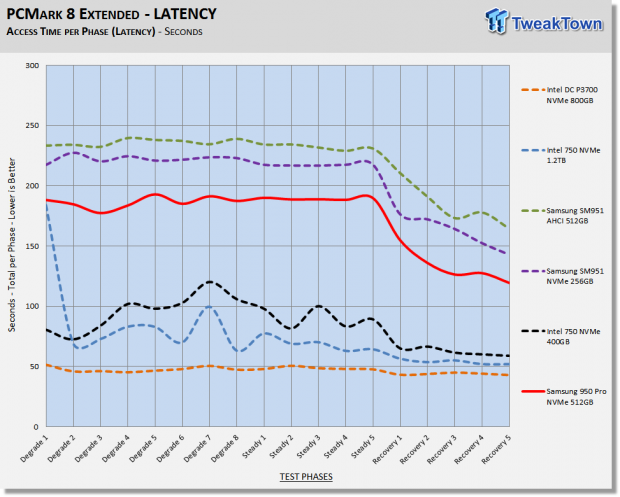
Disk Busy Time
Disk Busy Time is how long the disk is busy working. We chart the total time the disk is working as reported at each of the tests 18 trace iterations.
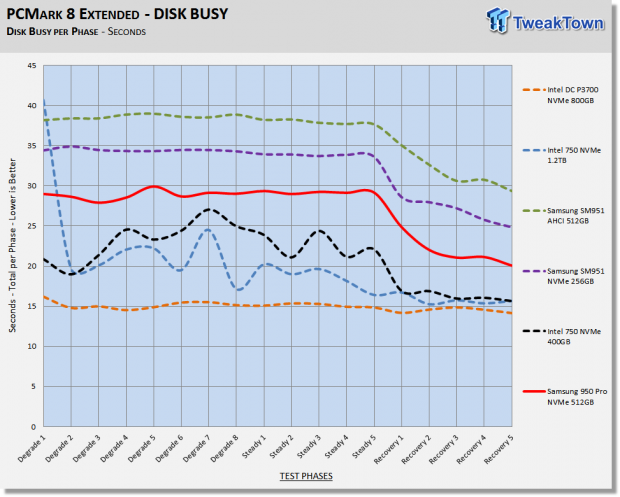
When latency is low, disk busy time is low as well. The Intel drives are spending much less time processing the data than the 950 Pro.
Data Written
We measure the total amount of random data that our test drive/array is capable of writing during the degradation phases of the consistency test. Pre-conditioning data is not included in the total. The total combined time that degradation data is written to the drive/array is 470 minutes. This can be very telling. The better a drive/array can process a continuous stream of random data, the more data will be written.
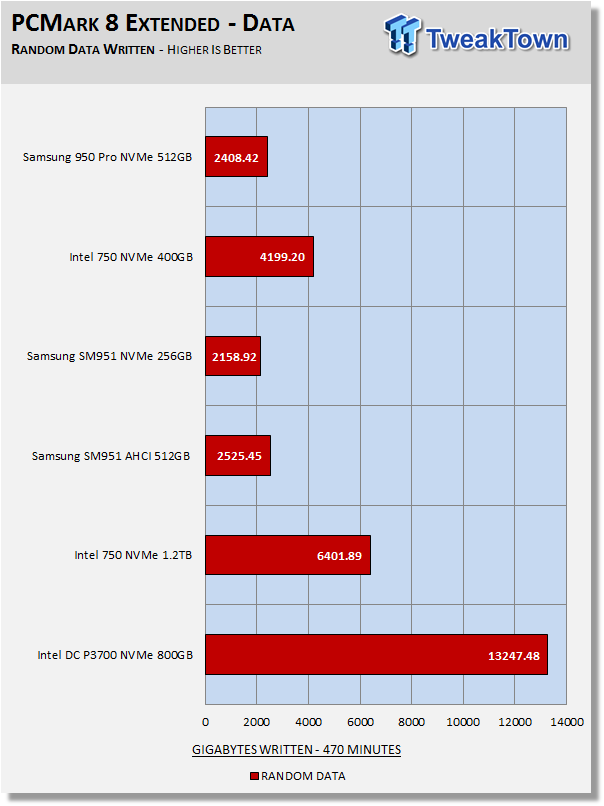
The outcome of this test is a direct result of low latency. The Intel drives have much lower latency throughout the tests than the 950 Pro does, and thus can write much more random data in the same amount of time.
Benchmarks (Secondary Volume) - 70/30 Mixed Workload
70/30 Mixed Workload Test (Sledgehammer)
Version and / or Patch Used: Iometer 2014
Heavy Workload Model
This test hammers a drive so hard we've dubbed it "Sledgehammer". Our 70/30 Mixed Workload test is an enterprise-class test designed to simulate a heavy-duty workstation steady-state environment. We feel that a mix of 70% read/30% write, full random 4K transfers best represents this type of user environment. Our test allows us to see the drive enter into and reach a steady state as the test progresses.
Phase one of the test preconditions the drive for 1 hour with 128K sequential writes. Phase two of the test runs a 70% read/30% write, full random 4K transfer workload on the drive for 1 hour. We log and chart (phase two) IOPS data at 5-second intervals for 1 hour (720 data points). 60 data points = 5 minutes.
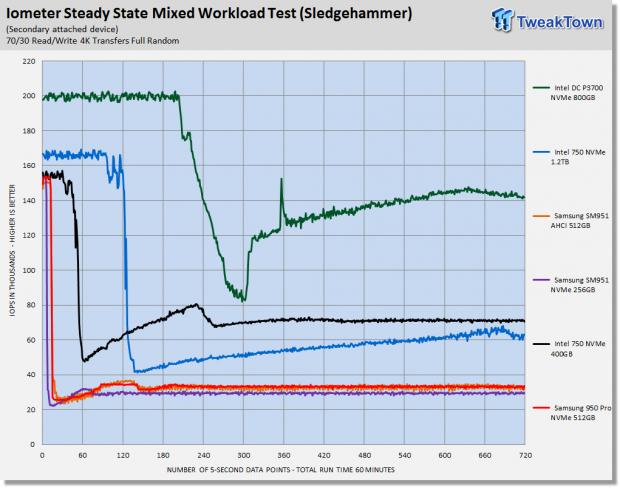
What we like about this test is that it reflects reality. Everything lines up, as it should. Consumer drives don't outperform Enterprise-Class SSDs that were designed for enterprise workloads. Consumer drives based on old technology are not outperforming modern Performance-Class SSD's, etc.
As we stated earlier, the 750 Series is more or less an enterprise SSD with consumer flash. This testing perfectly illustrates this fact. Enterprise class SSDs will always outperform consumer class SSD in this brutal test.
Maxed-Out Performance (MOP)
This testing is just to see what the drive is capable of in an FOB (Fresh Out of Box) state under optimal conditions. We are utilizing Windows Server 2008 R2 64-bit for this testing. Same Hardware, just an OS change.
We chose not to secure erase the 950 Pro before these tests, just a format and a TRIM. Keep in mind that if we did secure erase the 950 Pro prior to this round of testing the results would likely be even higher.
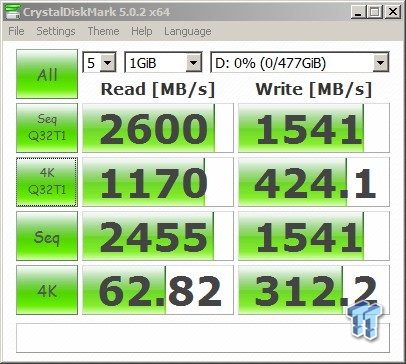
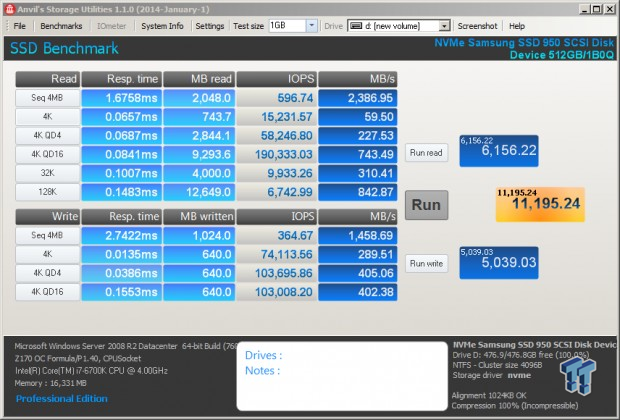
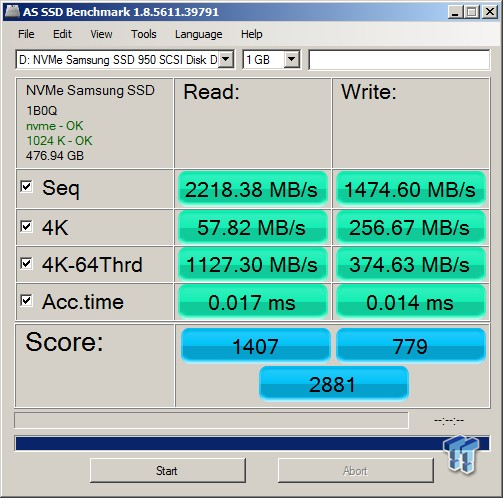
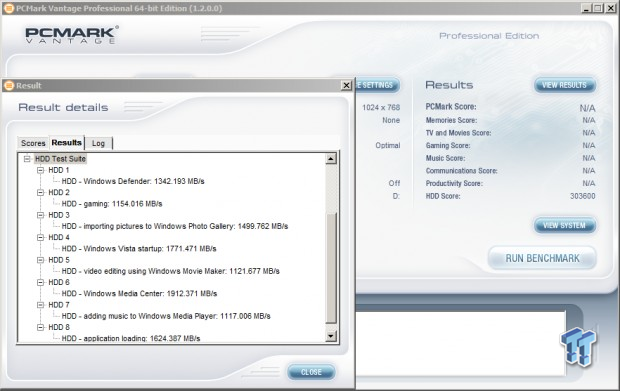
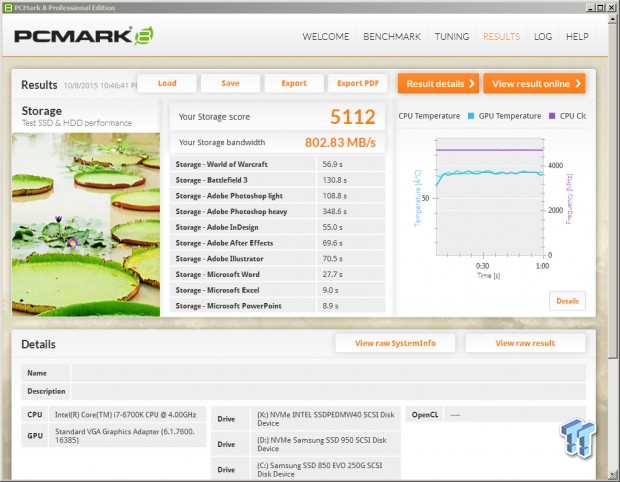
Typically, we don't comment on these tests, because the results pretty much speak for themselves. This time, however, we are going to comment on the PCMark 8 results. Over 800 MB/s storage bandwidth? That is much better than anything we've ever seen; arrays included. We are truly amazed by the 950 Pro.
Final Thoughts
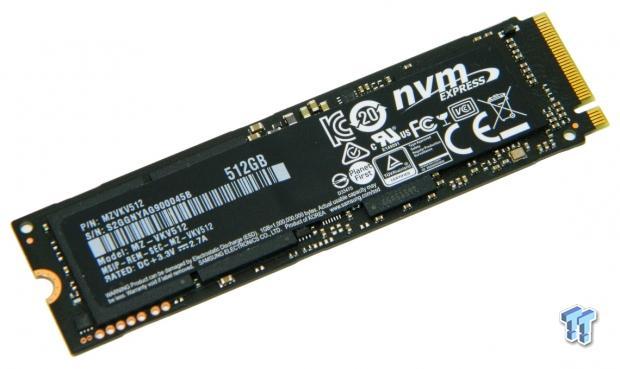
Samsung is targeting heavy workload professionals with the 950 Pro. Samsung states that the 950 Pro is ideal for intensive workloads, such as CAD drafting, data analysis, and engineering simulations. We agree the 950 Pro is indeed ideal for those applications, but we believe that even more than a workstation SSD, the 950 Pro is an enthusiast's dream come true.
Incorporating 3D Flash on an NVMe interface raises the performance bar to new heights. We are quite frankly amazed that an SSD this tiny is capable of generating this level of performance. The 950 Pro is capable of delivering sequential read performance of up to 5X that of SATA-based SSDs and up to 3X the sequential write performance.
The 950 Pro's sequential read/write performance is indeed impressive, but we are even more impressed with the drive's consumer workload performance. Looking at our standard PCMark 8 testing (moderate workload), the 950 Pro delivered 3X the performance of a typical consumer SATA-based SSD. Now that's impressive, but the fact that the 950 Pro outperformed the channel heavy, component laden, Intel 750 1.2TB NVMe SSD by over 44% just blows our minds.
We will admit we were a bit trepidatious before testing the 950 Pro, based on our experience with the OEM SM951 NVMe SSD. This proved to be unfounded as we experienced nothing but amazing hiccup-free performance from the 950 Pro. Samsung's proprietary NVMe driver worked its magic. The 950 Pro performed flawlessly and for the most part, we had no problem exceeding Samsung's specifications for the drive. The proprietary driver we used came in the form of an installer, which is fine for Windows 8.1 and 10 users, but without an F6 driver, typical Windows 7 users are out of luck in terms of running a 950 Pro as an OS disk. We hope that Samsung will provide an F6 NVMe driver for Windows 7 users.
We will also mention that the 950 Pro will be encryption enabled with a firmware update coming soon. Additionally, 950 Pro compatible Magician software (Version 4.8) should become available as you read this or shortly after. There will be a much needed secure erase feature, and we expect functional DRAM caching software to compliment the 950 Pro.
In the end, it all comes down to OS performance. TweakTown is in a somewhat unique position in this respect, because we are the only review site that we know of that performs most of our testing with the test subject running the OS and filled with data to 75% of the drive's capacity. Because of this we can comment on how the drive performs in a typical consumer setting. We can do this in just one sentence. The 950 Pro performs better than any consumer SSD we've ever used for an OS disk.
This is the first time that we have tested an SSD and had it turn out to be everything we hoped for. This is why the Samsung 950 Pro is the first SSD ever to receive a 100% TweakTown rating.
Pros:
- Quality 3D V-NAND MLC Flash
- Highest Performing Consumer SSD to Date
- Full 512GB Capacity
- Most Appealing Form Factor
Cons:
- None

| Performance | 100% |
| Quality including Design and Build | 100% |
| General Features | 100% |
| Bundle and Packaging | N/A |
| Value for Money | 100% |
| Overall | 100% |
The Bottom Line: Samsung's 950 Pro 512GB M.2 NVMe SSD is the first SSD ever to earn a 100 percent TweakTown rating. The 950 Pro is the best performing consumer SSD we've ever tested and we highly recommend you own this drive.
PRICING: You can find products similar to this one for sale below.
 United
States: Find other tech and computer products like this
over at Amazon.com
United
States: Find other tech and computer products like this
over at Amazon.com
 United
Kingdom: Find other tech and computer products like this
over at Amazon.co.uk
United
Kingdom: Find other tech and computer products like this
over at Amazon.co.uk
 Australia:
Find other tech and computer products like this over at Amazon.com.au
Australia:
Find other tech and computer products like this over at Amazon.com.au
 Canada:
Find other tech and computer products like this over at Amazon.ca
Canada:
Find other tech and computer products like this over at Amazon.ca
 Deutschland:
Finde andere Technik- und Computerprodukte wie dieses auf Amazon.de
Deutschland:
Finde andere Technik- und Computerprodukte wie dieses auf Amazon.de
What's in Jon's PC?
- CPU: AMD Ryzen 7800X 3D
- MOTHERBOARD: GIGABYTE AORUS Master X670E
- RAM: Kingston Fury Renegade 7200MHz 32GB
- GPU: ZOTAC AMP Extreme GeForce RTX 4090
- SSD: Crucial T700 2TB Gen5
- OS: Windows 11 Pro
- COOLER: Lian Li Galahad 360 AIO
- CASE: Lian Li Lancool III
- KEYBOARD: Corsair K65 RGB Mini
- MOUSE: SteelSeries AEROX 5 Wireless
- MONITOR: ASUS ROG Strix PG27AQN 360Hz 1440p ULMB2
Similar Content
Related Tags

